University Report: India's Economic Development Path from 1980 Onwards
VerifiedAdded on 2022/11/18
|19
|3304
|196
Report
AI Summary
This report provides a comprehensive analysis of India's economic development, examining its growth trajectory from 1980 to the present. The study delves into the social-cultural, political, and economic factors that have shaped India's development path, including the impact of the global financial crisis, demonetization, income inequality, and educational disparities. It explores key statistics such as the Human Development Index and per capita income, offering insights into areas requiring attention. The report references various development theories, like Rostow's model, and compares India's performance with other countries. It also highlights the influence of political policies, legal frameworks, and economic factors like productivity gains and external economies of scale. The report concludes by emphasizing the need to address inequalities to boost development and improve the social, economic, and political standing of Indian citizens. Data from various sources, including the World Bank, United Nations Development Programme and Trading Economics, are used to support the analysis.
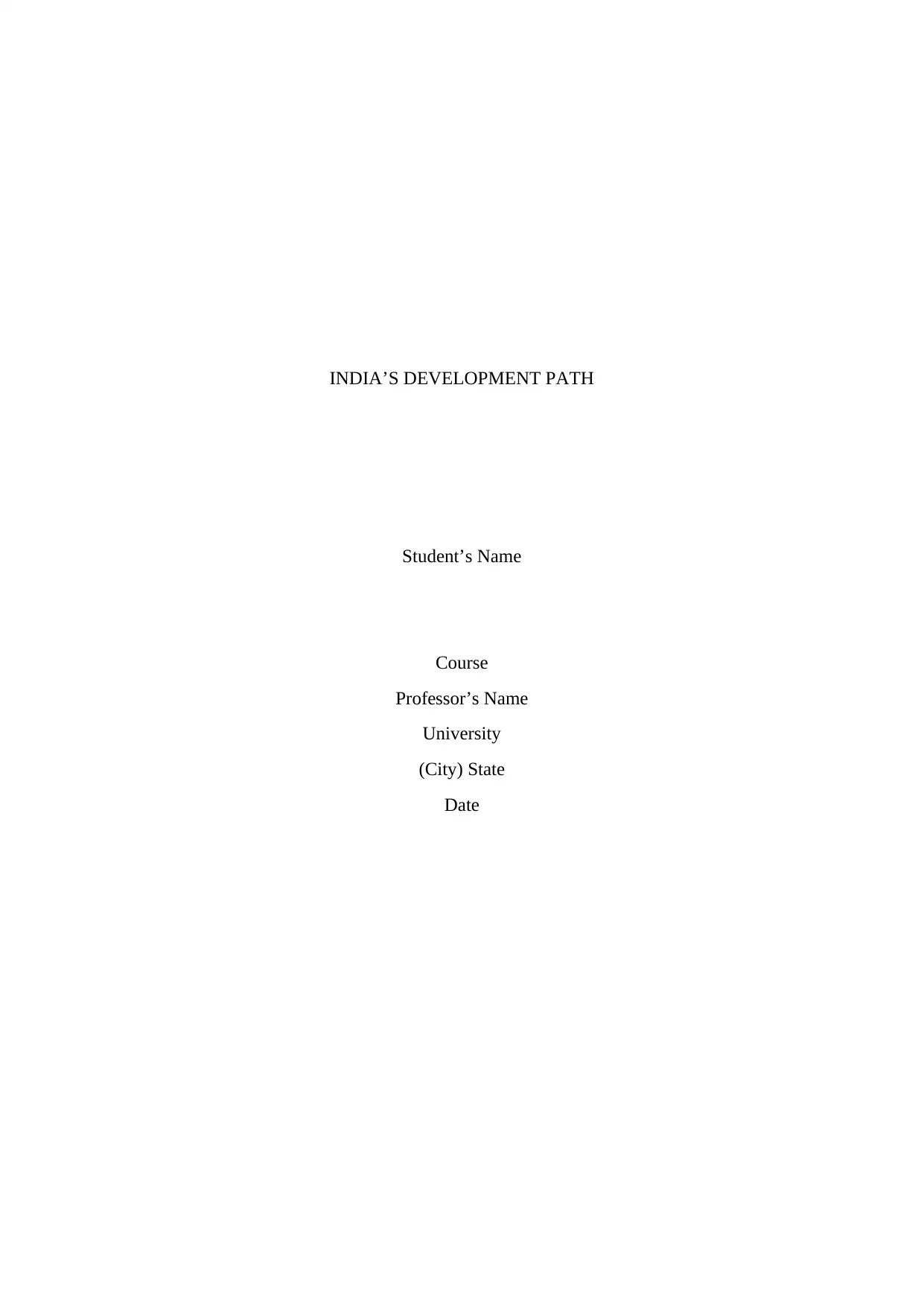
INDIA’S DEVELOPMENT PATH
Student’s Name
Course
Professor’s Name
University
(City) State
Date
Student’s Name
Course
Professor’s Name
University
(City) State
Date
Paraphrase This Document
Need a fresh take? Get an instant paraphrase of this document with our AI Paraphraser
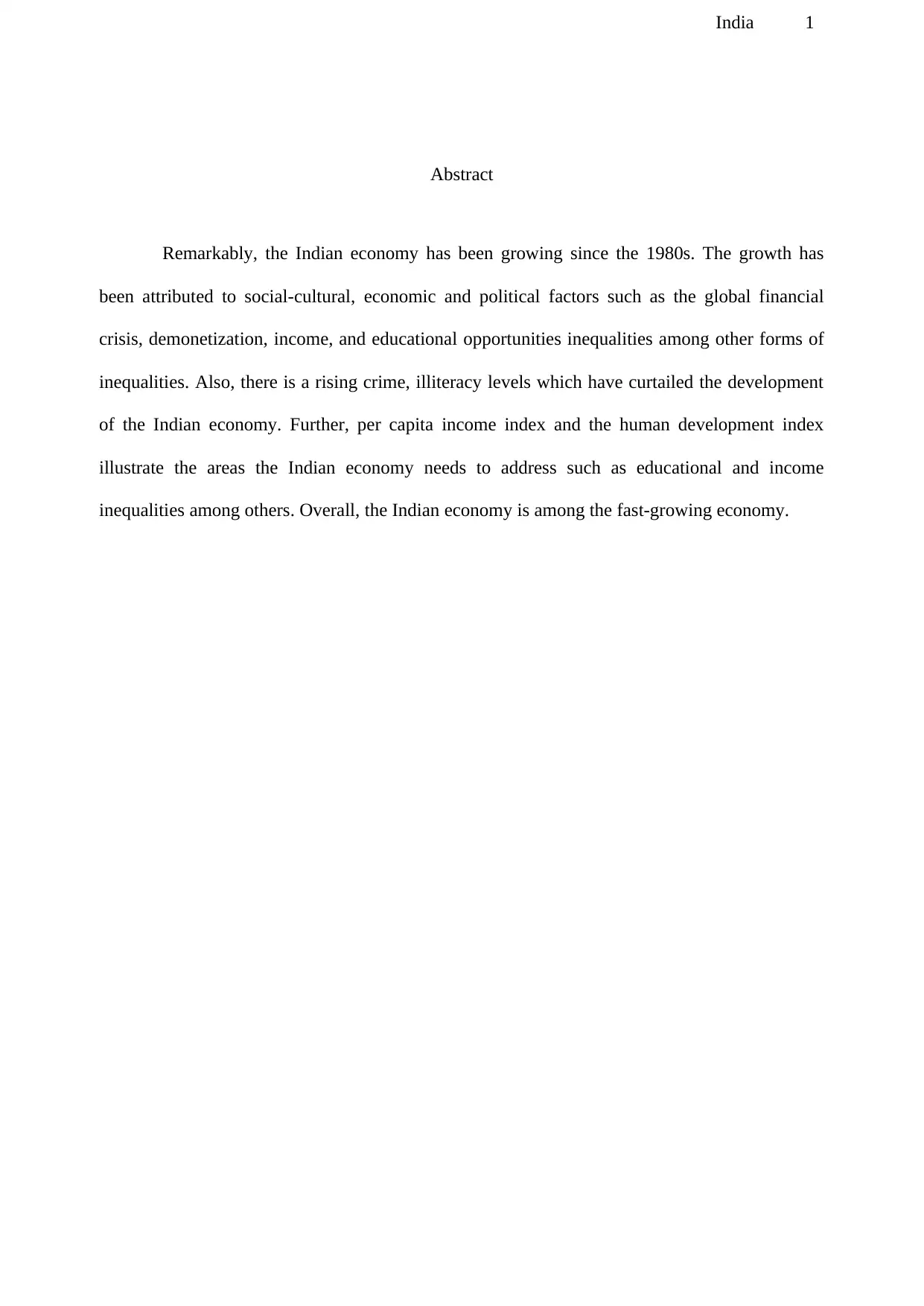
India 1
Abstract
Remarkably, the Indian economy has been growing since the 1980s. The growth has
been attributed to social-cultural, economic and political factors such as the global financial
crisis, demonetization, income, and educational opportunities inequalities among other forms of
inequalities. Also, there is a rising crime, illiteracy levels which have curtailed the development
of the Indian economy. Further, per capita income index and the human development index
illustrate the areas the Indian economy needs to address such as educational and income
inequalities among others. Overall, the Indian economy is among the fast-growing economy.
Abstract
Remarkably, the Indian economy has been growing since the 1980s. The growth has
been attributed to social-cultural, economic and political factors such as the global financial
crisis, demonetization, income, and educational opportunities inequalities among other forms of
inequalities. Also, there is a rising crime, illiteracy levels which have curtailed the development
of the Indian economy. Further, per capita income index and the human development index
illustrate the areas the Indian economy needs to address such as educational and income
inequalities among others. Overall, the Indian economy is among the fast-growing economy.
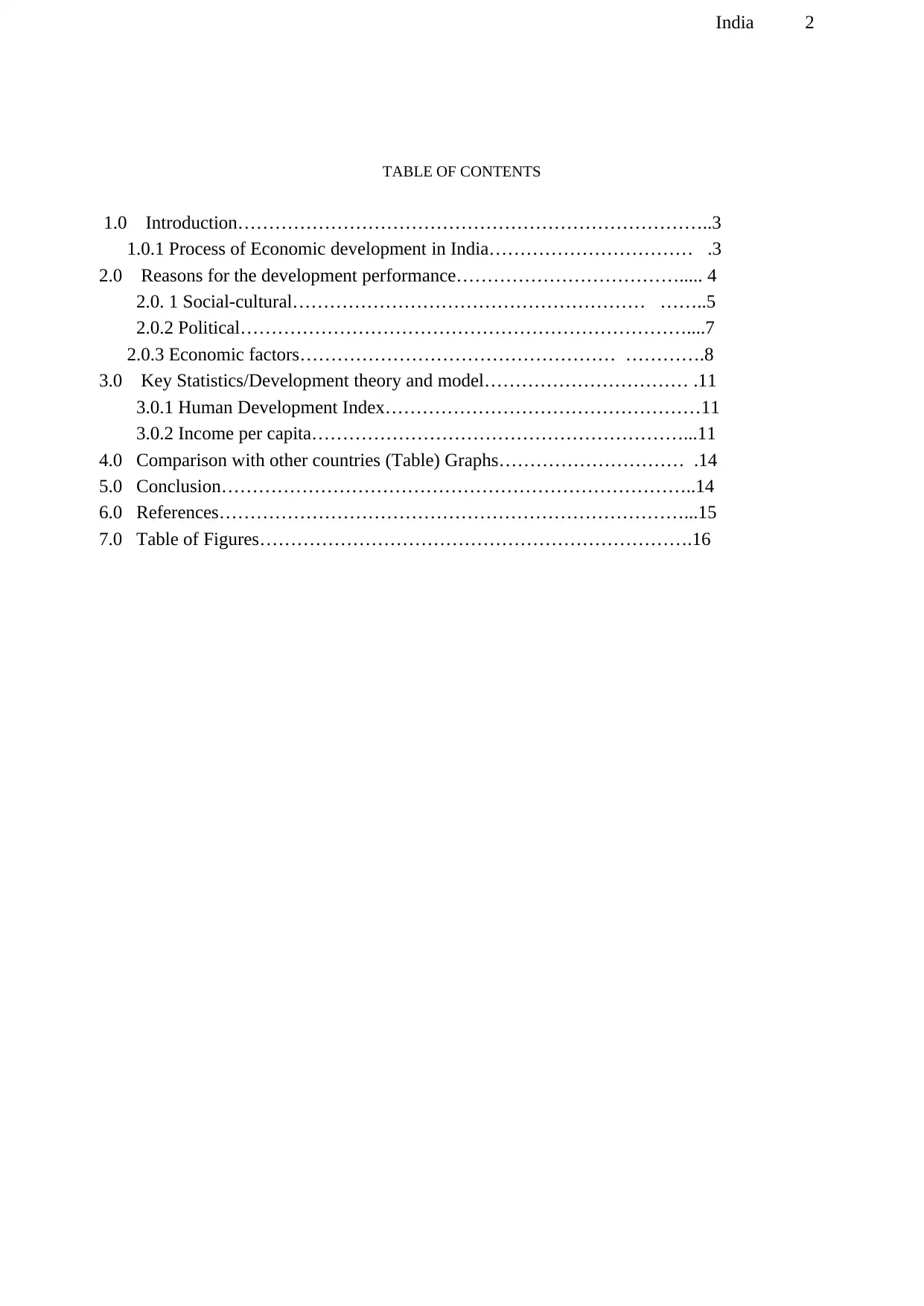
India 2
TABLE OF CONTENTS
1.0 Introduction…………………………………………………………………..3
1.0.1 Process of Economic development in India…………………………… .3
2.0 Reasons for the development performance………………………………..... 4
2.0. 1 Social-cultural………………………………………………… ……..5
2.0.2 Political………………………………………………………………....7
2.0.3 Economic factors…………………………………………… ………….8
3.0 Key Statistics/Development theory and model…………………………… .11
3.0.1 Human Development Index……………………………………………11
3.0.2 Income per capita……………………………………………………...11
4.0 Comparison with other countries (Table) Graphs………………………… .14
5.0 Conclusion…………………………………………………………………..14
6.0 References…………………………………………………………………...15
7.0 Table of Figures…………………………………………………………….16
TABLE OF CONTENTS
1.0 Introduction…………………………………………………………………..3
1.0.1 Process of Economic development in India…………………………… .3
2.0 Reasons for the development performance………………………………..... 4
2.0. 1 Social-cultural………………………………………………… ……..5
2.0.2 Political………………………………………………………………....7
2.0.3 Economic factors…………………………………………… ………….8
3.0 Key Statistics/Development theory and model…………………………… .11
3.0.1 Human Development Index……………………………………………11
3.0.2 Income per capita……………………………………………………...11
4.0 Comparison with other countries (Table) Graphs………………………… .14
5.0 Conclusion…………………………………………………………………..14
6.0 References…………………………………………………………………...15
7.0 Table of Figures…………………………………………………………….16
⊘ This is a preview!⊘
Do you want full access?
Subscribe today to unlock all pages.

Trusted by 1+ million students worldwide
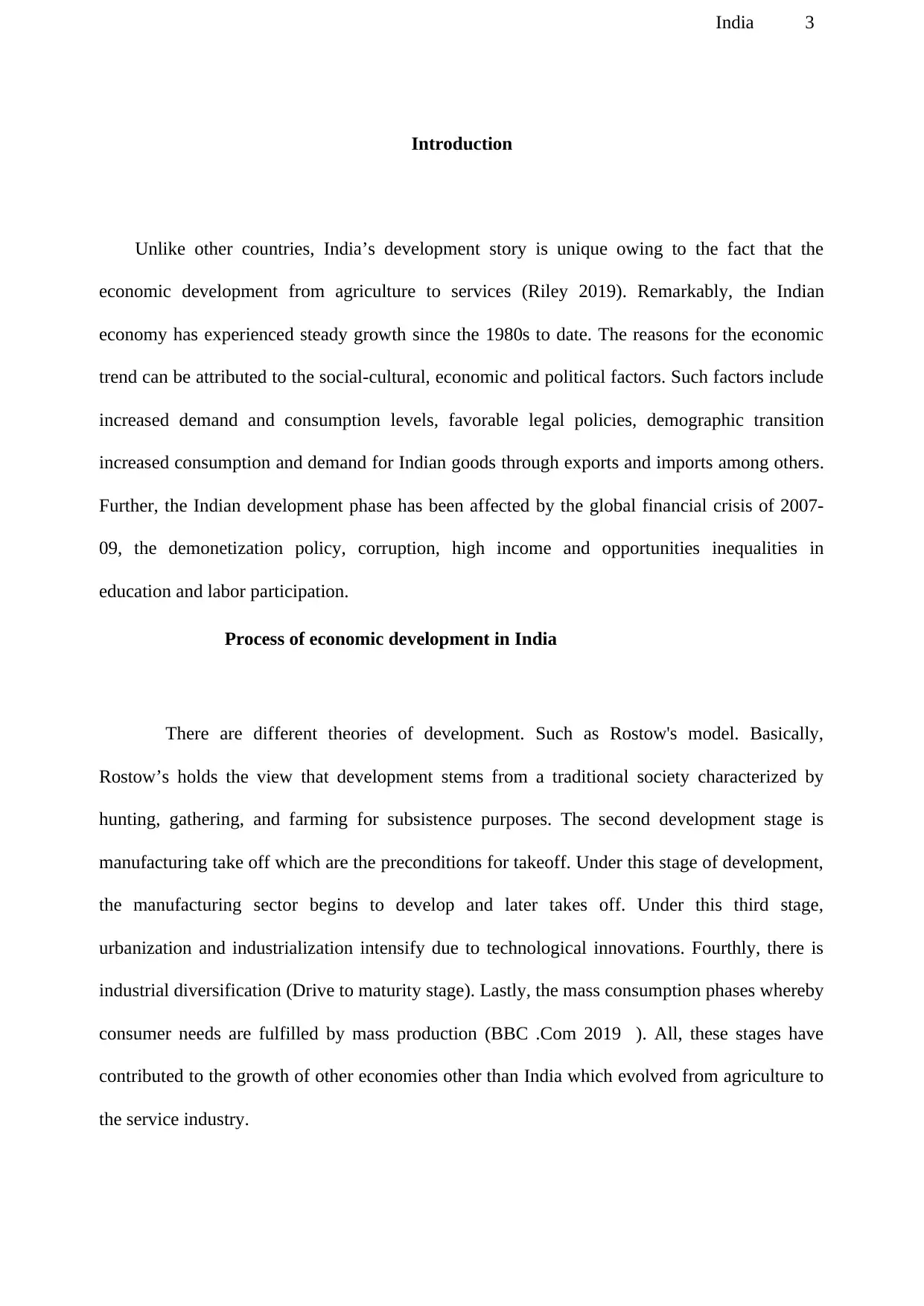
India 3
Introduction
Unlike other countries, India’s development story is unique owing to the fact that the
economic development from agriculture to services (Riley 2019). Remarkably, the Indian
economy has experienced steady growth since the 1980s to date. The reasons for the economic
trend can be attributed to the social-cultural, economic and political factors. Such factors include
increased demand and consumption levels, favorable legal policies, demographic transition
increased consumption and demand for Indian goods through exports and imports among others.
Further, the Indian development phase has been affected by the global financial crisis of 2007-
09, the demonetization policy, corruption, high income and opportunities inequalities in
education and labor participation.
Process of economic development in India
There are different theories of development. Such as Rostow's model. Basically,
Rostow’s holds the view that development stems from a traditional society characterized by
hunting, gathering, and farming for subsistence purposes. The second development stage is
manufacturing take off which are the preconditions for takeoff. Under this stage of development,
the manufacturing sector begins to develop and later takes off. Under this third stage,
urbanization and industrialization intensify due to technological innovations. Fourthly, there is
industrial diversification (Drive to maturity stage). Lastly, the mass consumption phases whereby
consumer needs are fulfilled by mass production (BBC .Com 2019 ). All, these stages have
contributed to the growth of other economies other than India which evolved from agriculture to
the service industry.
Introduction
Unlike other countries, India’s development story is unique owing to the fact that the
economic development from agriculture to services (Riley 2019). Remarkably, the Indian
economy has experienced steady growth since the 1980s to date. The reasons for the economic
trend can be attributed to the social-cultural, economic and political factors. Such factors include
increased demand and consumption levels, favorable legal policies, demographic transition
increased consumption and demand for Indian goods through exports and imports among others.
Further, the Indian development phase has been affected by the global financial crisis of 2007-
09, the demonetization policy, corruption, high income and opportunities inequalities in
education and labor participation.
Process of economic development in India
There are different theories of development. Such as Rostow's model. Basically,
Rostow’s holds the view that development stems from a traditional society characterized by
hunting, gathering, and farming for subsistence purposes. The second development stage is
manufacturing take off which are the preconditions for takeoff. Under this stage of development,
the manufacturing sector begins to develop and later takes off. Under this third stage,
urbanization and industrialization intensify due to technological innovations. Fourthly, there is
industrial diversification (Drive to maturity stage). Lastly, the mass consumption phases whereby
consumer needs are fulfilled by mass production (BBC .Com 2019 ). All, these stages have
contributed to the growth of other economies other than India which evolved from agriculture to
the service industry.
Paraphrase This Document
Need a fresh take? Get an instant paraphrase of this document with our AI Paraphraser
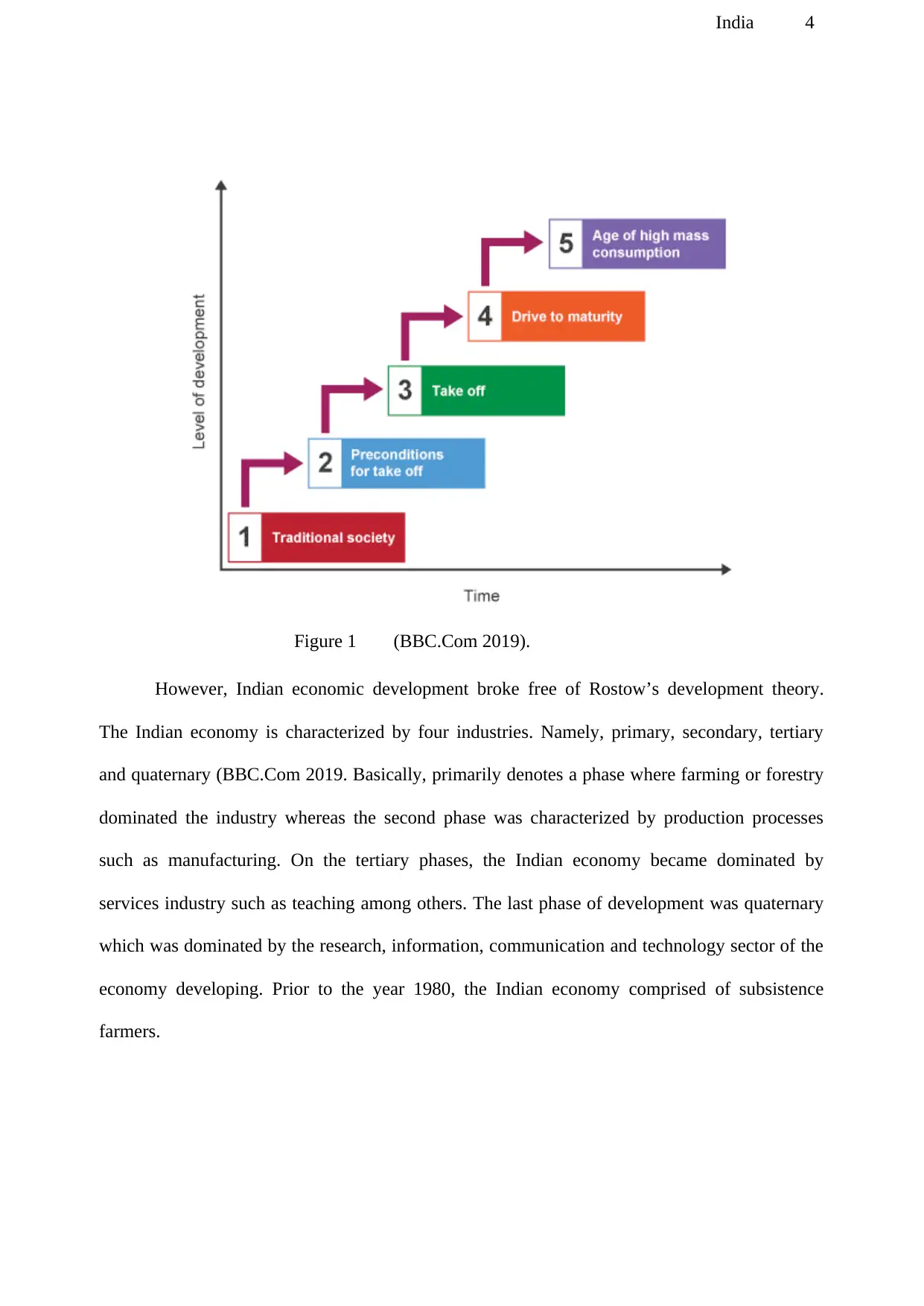
India 4
Figure 1 (BBC.Com 2019).
However, Indian economic development broke free of Rostow’s development theory.
The Indian economy is characterized by four industries. Namely, primary, secondary, tertiary
and quaternary (BBC.Com 2019. Basically, primarily denotes a phase where farming or forestry
dominated the industry whereas the second phase was characterized by production processes
such as manufacturing. On the tertiary phases, the Indian economy became dominated by
services industry such as teaching among others. The last phase of development was quaternary
which was dominated by the research, information, communication and technology sector of the
economy developing. Prior to the year 1980, the Indian economy comprised of subsistence
farmers.
Figure 1 (BBC.Com 2019).
However, Indian economic development broke free of Rostow’s development theory.
The Indian economy is characterized by four industries. Namely, primary, secondary, tertiary
and quaternary (BBC.Com 2019. Basically, primarily denotes a phase where farming or forestry
dominated the industry whereas the second phase was characterized by production processes
such as manufacturing. On the tertiary phases, the Indian economy became dominated by
services industry such as teaching among others. The last phase of development was quaternary
which was dominated by the research, information, communication and technology sector of the
economy developing. Prior to the year 1980, the Indian economy comprised of subsistence
farmers.
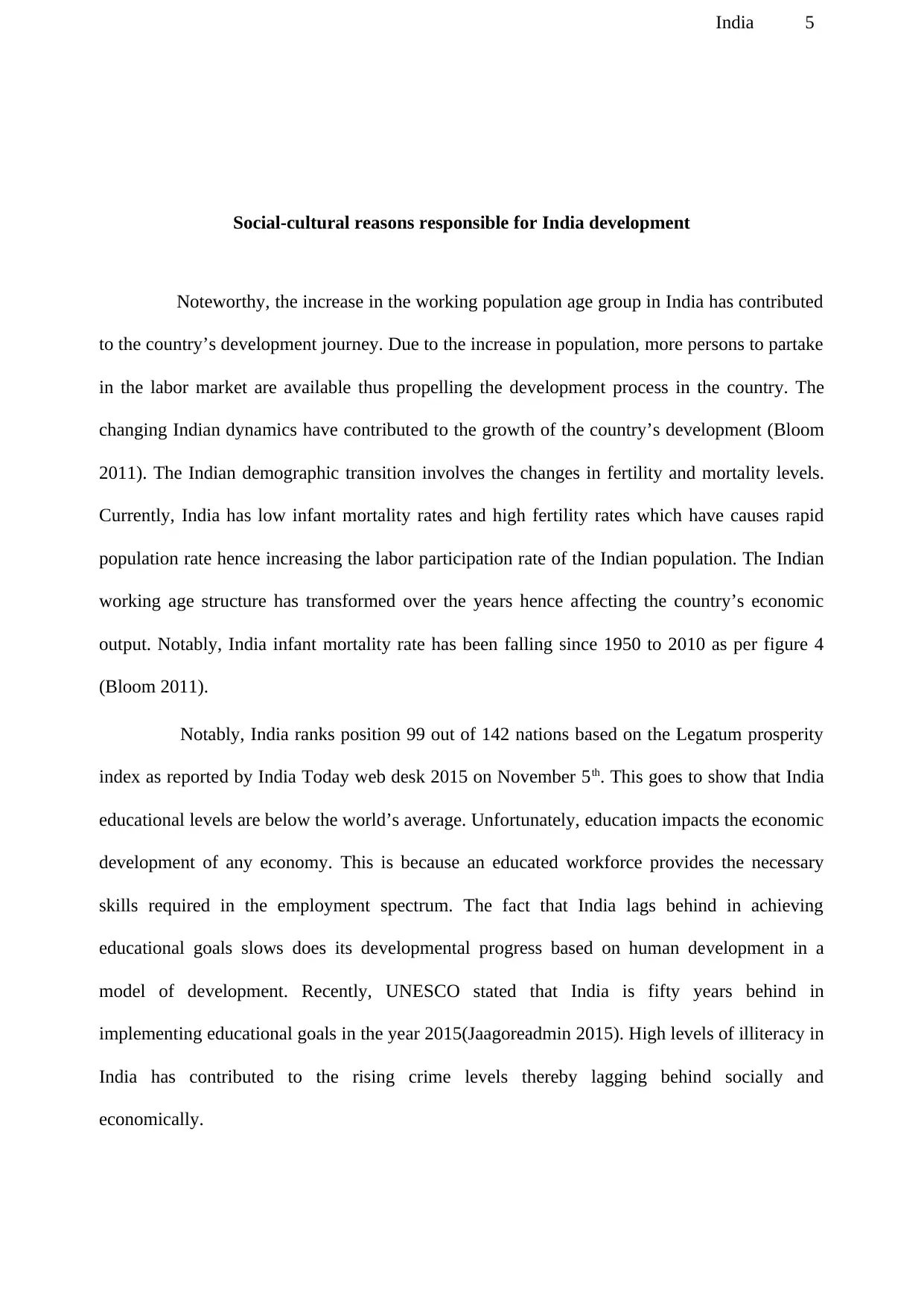
India 5
Social-cultural reasons responsible for India development
Noteworthy, the increase in the working population age group in India has contributed
to the country’s development journey. Due to the increase in population, more persons to partake
in the labor market are available thus propelling the development process in the country. The
changing Indian dynamics have contributed to the growth of the country’s development (Bloom
2011). The Indian demographic transition involves the changes in fertility and mortality levels.
Currently, India has low infant mortality rates and high fertility rates which have causes rapid
population rate hence increasing the labor participation rate of the Indian population. The Indian
working age structure has transformed over the years hence affecting the country’s economic
output. Notably, India infant mortality rate has been falling since 1950 to 2010 as per figure 4
(Bloom 2011).
Notably, India ranks position 99 out of 142 nations based on the Legatum prosperity
index as reported by India Today web desk 2015 on November 5th. This goes to show that India
educational levels are below the world’s average. Unfortunately, education impacts the economic
development of any economy. This is because an educated workforce provides the necessary
skills required in the employment spectrum. The fact that India lags behind in achieving
educational goals slows does its developmental progress based on human development in a
model of development. Recently, UNESCO stated that India is fifty years behind in
implementing educational goals in the year 2015(Jaagoreadmin 2015). High levels of illiteracy in
India has contributed to the rising crime levels thereby lagging behind socially and
economically.
Social-cultural reasons responsible for India development
Noteworthy, the increase in the working population age group in India has contributed
to the country’s development journey. Due to the increase in population, more persons to partake
in the labor market are available thus propelling the development process in the country. The
changing Indian dynamics have contributed to the growth of the country’s development (Bloom
2011). The Indian demographic transition involves the changes in fertility and mortality levels.
Currently, India has low infant mortality rates and high fertility rates which have causes rapid
population rate hence increasing the labor participation rate of the Indian population. The Indian
working age structure has transformed over the years hence affecting the country’s economic
output. Notably, India infant mortality rate has been falling since 1950 to 2010 as per figure 4
(Bloom 2011).
Notably, India ranks position 99 out of 142 nations based on the Legatum prosperity
index as reported by India Today web desk 2015 on November 5th. This goes to show that India
educational levels are below the world’s average. Unfortunately, education impacts the economic
development of any economy. This is because an educated workforce provides the necessary
skills required in the employment spectrum. The fact that India lags behind in achieving
educational goals slows does its developmental progress based on human development in a
model of development. Recently, UNESCO stated that India is fifty years behind in
implementing educational goals in the year 2015(Jaagoreadmin 2015). High levels of illiteracy in
India has contributed to the rising crime levels thereby lagging behind socially and
economically.
⊘ This is a preview!⊘
Do you want full access?
Subscribe today to unlock all pages.

Trusted by 1+ million students worldwide

India 6
Further, the fact that part of the Sustainable development goals for the years 2030
seeks to guaranteed free, equitable access to educations for all primary and secondary students is
far from being achieved in India. The Indian international obligations to SDGS regarding
education is far from being achieved as illustrated by the Lorenz curve below. Additionally, the
current educations system in India is yet to embrace global education changes and curriculum
(Jaagoreadmin 2015). This goes to show the educational background of Indian workers is not up
to par with the global standards thus reducing their competitiveness on the global economy. The
cultural attitudes in India towards the educational and economic empowerment of the female
population is evolving
Figure 2 (Economic policy and date center 2012)
Further, the fact that part of the Sustainable development goals for the years 2030
seeks to guaranteed free, equitable access to educations for all primary and secondary students is
far from being achieved in India. The Indian international obligations to SDGS regarding
education is far from being achieved as illustrated by the Lorenz curve below. Additionally, the
current educations system in India is yet to embrace global education changes and curriculum
(Jaagoreadmin 2015). This goes to show the educational background of Indian workers is not up
to par with the global standards thus reducing their competitiveness on the global economy. The
cultural attitudes in India towards the educational and economic empowerment of the female
population is evolving
Figure 2 (Economic policy and date center 2012)
Paraphrase This Document
Need a fresh take? Get an instant paraphrase of this document with our AI Paraphraser

India 7
Political factors
Worth noting, the Indian government has created a sound legal framework which has
fostered the development of domestic and foreign companies. Specifically, a sound legal
framework exists for the outsourcing of information technology (Riley 2019). Following the
demonetization policy by the Indian BJP-National Democratic Alliance, the Indian per capita
income growth slowed down (Dhasmana 2018). The political players in India are responsible for
making policies that impact the economic performance of the India economy. For instance, the
introduction of the goods and service Tax (GST). It is expected to stimulate economic growth in
the country by eliminating the cascading tax effects on goods and services, reducing costs in
manufacturing while boosting the demand and consumption of goods and services.
The fights against corruption in India is far from being won by the under the current Indian
political landscape (BBC .Com 2011). In most economies, the political government is
responsible for putting into place mechanisms and resources to fight economic crimes. The same
can be said for the Indian system whereby legislation and enforcement mechanisms are
appointed by political leaders. Based on KPMG reporting, corruption was a huge deterrent for
foreign investors to consider India as a business environment. Arguably, the current legal system
to fight corruption under the current political and judicial leadership has failed to eradicate the
corruption menace hence there is mismanagement of public resources to the disadvantage of the
Indian population. It is imperative that the Indian political leaders implemented stricter penalties
for corruption in the public service.
Political factors
Worth noting, the Indian government has created a sound legal framework which has
fostered the development of domestic and foreign companies. Specifically, a sound legal
framework exists for the outsourcing of information technology (Riley 2019). Following the
demonetization policy by the Indian BJP-National Democratic Alliance, the Indian per capita
income growth slowed down (Dhasmana 2018). The political players in India are responsible for
making policies that impact the economic performance of the India economy. For instance, the
introduction of the goods and service Tax (GST). It is expected to stimulate economic growth in
the country by eliminating the cascading tax effects on goods and services, reducing costs in
manufacturing while boosting the demand and consumption of goods and services.
The fights against corruption in India is far from being won by the under the current Indian
political landscape (BBC .Com 2011). In most economies, the political government is
responsible for putting into place mechanisms and resources to fight economic crimes. The same
can be said for the Indian system whereby legislation and enforcement mechanisms are
appointed by political leaders. Based on KPMG reporting, corruption was a huge deterrent for
foreign investors to consider India as a business environment. Arguably, the current legal system
to fight corruption under the current political and judicial leadership has failed to eradicate the
corruption menace hence there is mismanagement of public resources to the disadvantage of the
Indian population. It is imperative that the Indian political leaders implemented stricter penalties
for corruption in the public service.
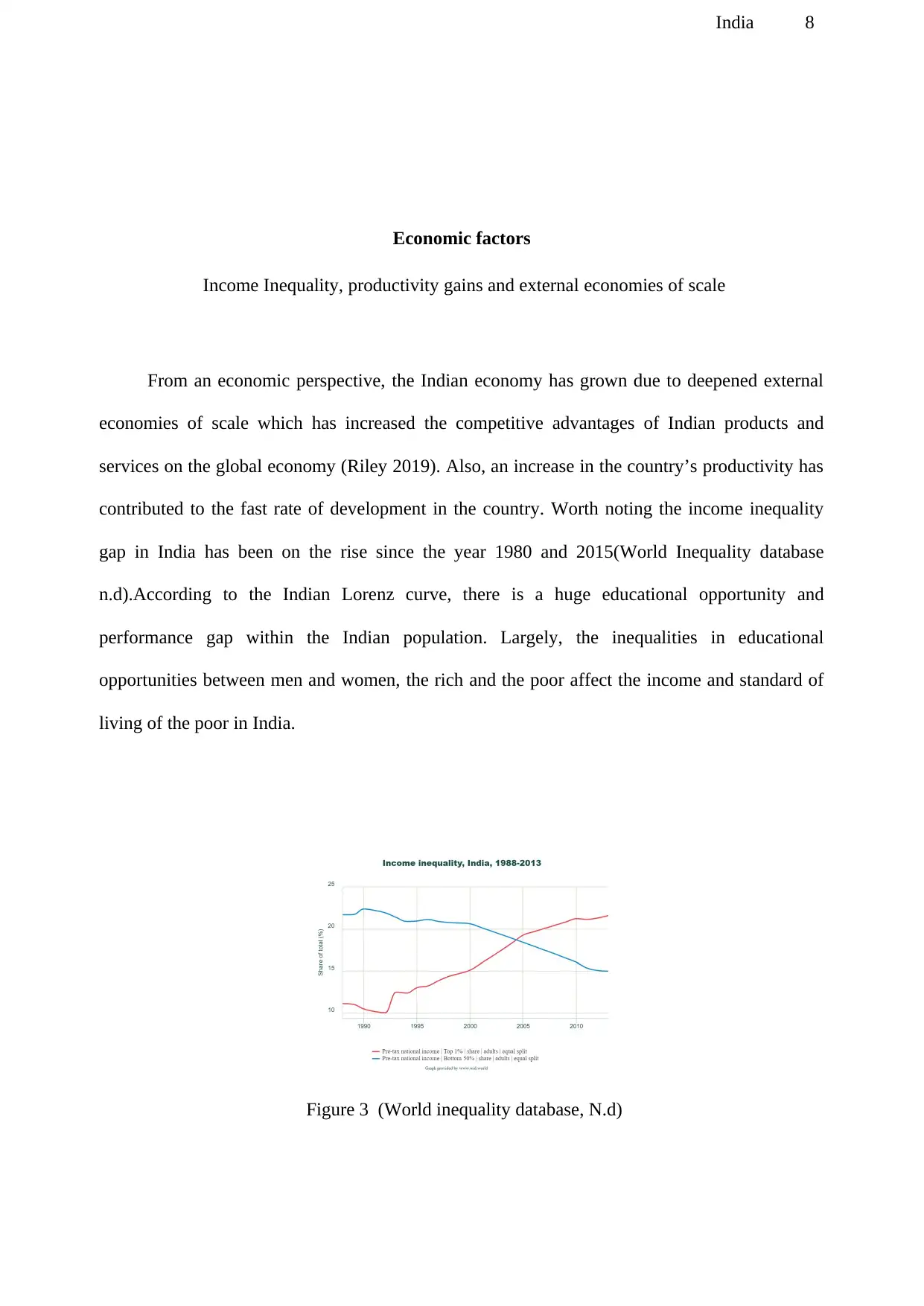
India 8
Economic factors
Income Inequality, productivity gains and external economies of scale
From an economic perspective, the Indian economy has grown due to deepened external
economies of scale which has increased the competitive advantages of Indian products and
services on the global economy (Riley 2019). Also, an increase in the country’s productivity has
contributed to the fast rate of development in the country. Worth noting the income inequality
gap in India has been on the rise since the year 1980 and 2015(World Inequality database
n.d).According to the Indian Lorenz curve, there is a huge educational opportunity and
performance gap within the Indian population. Largely, the inequalities in educational
opportunities between men and women, the rich and the poor affect the income and standard of
living of the poor in India.
Figure 3 (World inequality database, N.d)
Economic factors
Income Inequality, productivity gains and external economies of scale
From an economic perspective, the Indian economy has grown due to deepened external
economies of scale which has increased the competitive advantages of Indian products and
services on the global economy (Riley 2019). Also, an increase in the country’s productivity has
contributed to the fast rate of development in the country. Worth noting the income inequality
gap in India has been on the rise since the year 1980 and 2015(World Inequality database
n.d).According to the Indian Lorenz curve, there is a huge educational opportunity and
performance gap within the Indian population. Largely, the inequalities in educational
opportunities between men and women, the rich and the poor affect the income and standard of
living of the poor in India.
Figure 3 (World inequality database, N.d)
⊘ This is a preview!⊘
Do you want full access?
Subscribe today to unlock all pages.

Trusted by 1+ million students worldwide
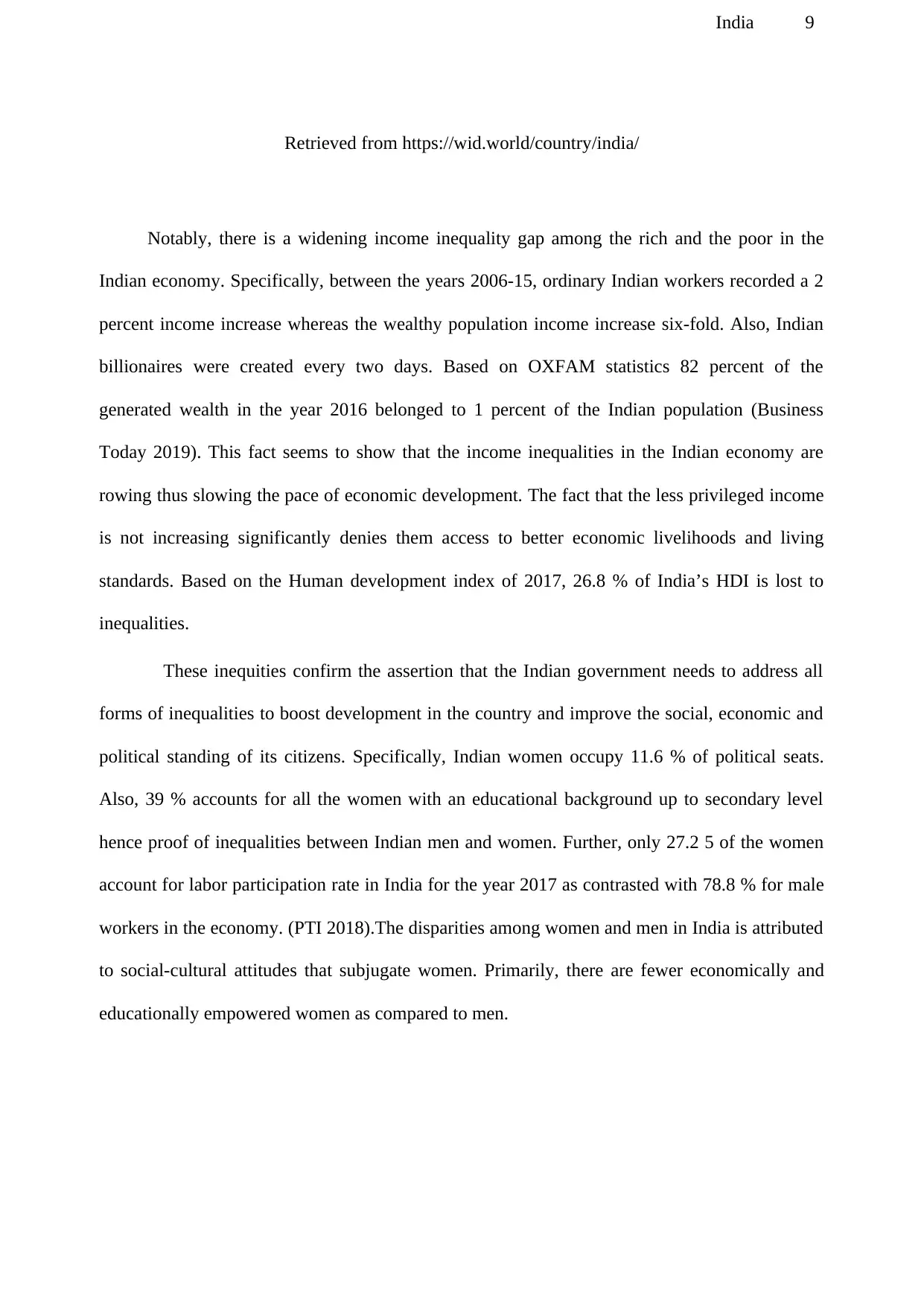
India 9
Retrieved from https://wid.world/country/india/
Notably, there is a widening income inequality gap among the rich and the poor in the
Indian economy. Specifically, between the years 2006-15, ordinary Indian workers recorded a 2
percent income increase whereas the wealthy population income increase six-fold. Also, Indian
billionaires were created every two days. Based on OXFAM statistics 82 percent of the
generated wealth in the year 2016 belonged to 1 percent of the Indian population (Business
Today 2019). This fact seems to show that the income inequalities in the Indian economy are
rowing thus slowing the pace of economic development. The fact that the less privileged income
is not increasing significantly denies them access to better economic livelihoods and living
standards. Based on the Human development index of 2017, 26.8 % of India’s HDI is lost to
inequalities.
These inequities confirm the assertion that the Indian government needs to address all
forms of inequalities to boost development in the country and improve the social, economic and
political standing of its citizens. Specifically, Indian women occupy 11.6 % of political seats.
Also, 39 % accounts for all the women with an educational background up to secondary level
hence proof of inequalities between Indian men and women. Further, only 27.2 5 of the women
account for labor participation rate in India for the year 2017 as contrasted with 78.8 % for male
workers in the economy. (PTI 2018).The disparities among women and men in India is attributed
to social-cultural attitudes that subjugate women. Primarily, there are fewer economically and
educationally empowered women as compared to men.
Retrieved from https://wid.world/country/india/
Notably, there is a widening income inequality gap among the rich and the poor in the
Indian economy. Specifically, between the years 2006-15, ordinary Indian workers recorded a 2
percent income increase whereas the wealthy population income increase six-fold. Also, Indian
billionaires were created every two days. Based on OXFAM statistics 82 percent of the
generated wealth in the year 2016 belonged to 1 percent of the Indian population (Business
Today 2019). This fact seems to show that the income inequalities in the Indian economy are
rowing thus slowing the pace of economic development. The fact that the less privileged income
is not increasing significantly denies them access to better economic livelihoods and living
standards. Based on the Human development index of 2017, 26.8 % of India’s HDI is lost to
inequalities.
These inequities confirm the assertion that the Indian government needs to address all
forms of inequalities to boost development in the country and improve the social, economic and
political standing of its citizens. Specifically, Indian women occupy 11.6 % of political seats.
Also, 39 % accounts for all the women with an educational background up to secondary level
hence proof of inequalities between Indian men and women. Further, only 27.2 5 of the women
account for labor participation rate in India for the year 2017 as contrasted with 78.8 % for male
workers in the economy. (PTI 2018).The disparities among women and men in India is attributed
to social-cultural attitudes that subjugate women. Primarily, there are fewer economically and
educationally empowered women as compared to men.
Paraphrase This Document
Need a fresh take? Get an instant paraphrase of this document with our AI Paraphraser
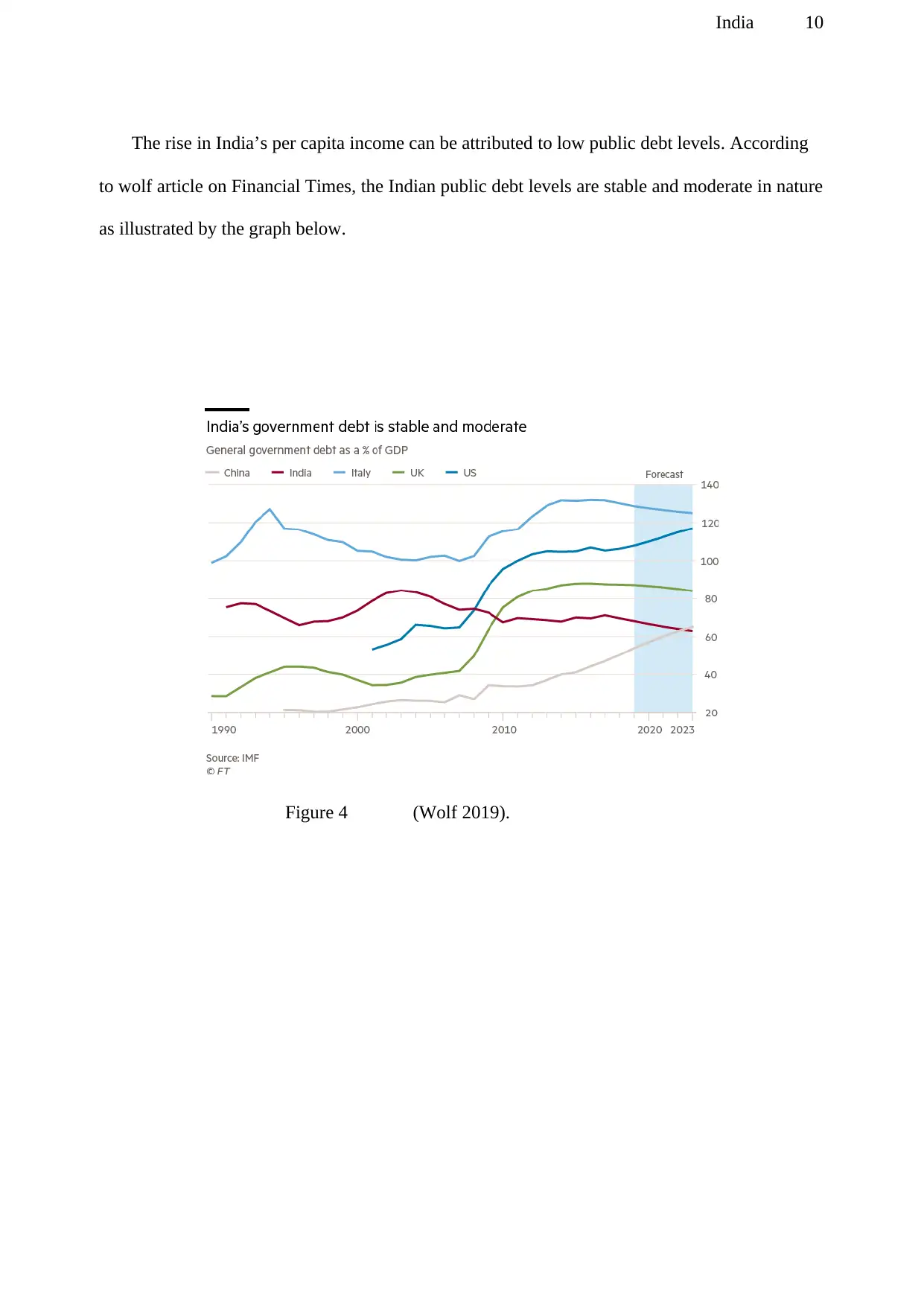
India 10
The rise in India’s per capita income can be attributed to low public debt levels. According
to wolf article on Financial Times, the Indian public debt levels are stable and moderate in nature
as illustrated by the graph below.
Figure 4 (Wolf 2019).
The rise in India’s per capita income can be attributed to low public debt levels. According
to wolf article on Financial Times, the Indian public debt levels are stable and moderate in nature
as illustrated by the graph below.
Figure 4 (Wolf 2019).
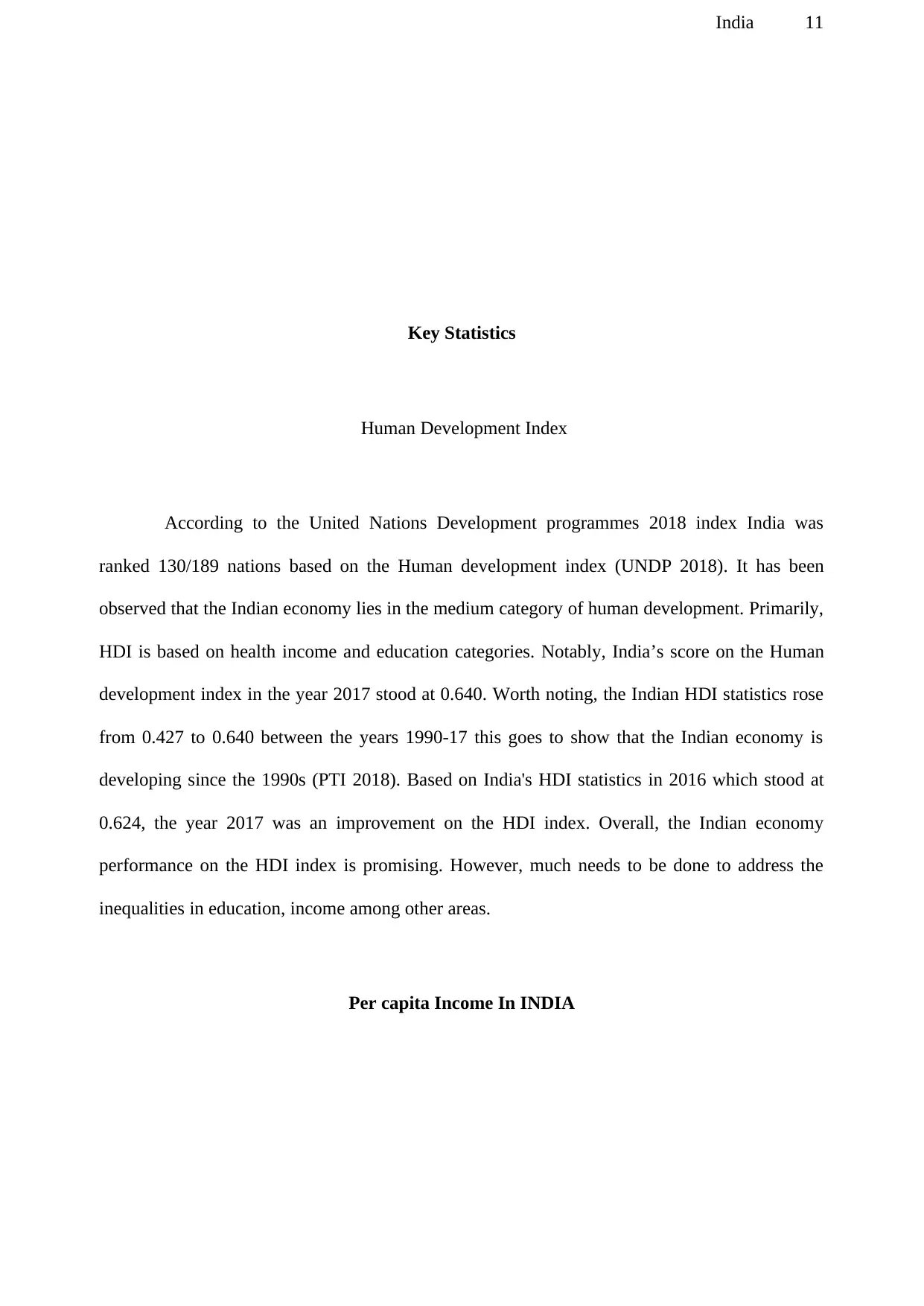
India 11
Key Statistics
Human Development Index
According to the United Nations Development programmes 2018 index India was
ranked 130/189 nations based on the Human development index (UNDP 2018). It has been
observed that the Indian economy lies in the medium category of human development. Primarily,
HDI is based on health income and education categories. Notably, India’s score on the Human
development index in the year 2017 stood at 0.640. Worth noting, the Indian HDI statistics rose
from 0.427 to 0.640 between the years 1990-17 this goes to show that the Indian economy is
developing since the 1990s (PTI 2018). Based on India's HDI statistics in 2016 which stood at
0.624, the year 2017 was an improvement on the HDI index. Overall, the Indian economy
performance on the HDI index is promising. However, much needs to be done to address the
inequalities in education, income among other areas.
Per capita Income In INDIA
Key Statistics
Human Development Index
According to the United Nations Development programmes 2018 index India was
ranked 130/189 nations based on the Human development index (UNDP 2018). It has been
observed that the Indian economy lies in the medium category of human development. Primarily,
HDI is based on health income and education categories. Notably, India’s score on the Human
development index in the year 2017 stood at 0.640. Worth noting, the Indian HDI statistics rose
from 0.427 to 0.640 between the years 1990-17 this goes to show that the Indian economy is
developing since the 1990s (PTI 2018). Based on India's HDI statistics in 2016 which stood at
0.624, the year 2017 was an improvement on the HDI index. Overall, the Indian economy
performance on the HDI index is promising. However, much needs to be done to address the
inequalities in education, income among other areas.
Per capita Income In INDIA
⊘ This is a preview!⊘
Do you want full access?
Subscribe today to unlock all pages.

Trusted by 1+ million students worldwide
1 out of 19